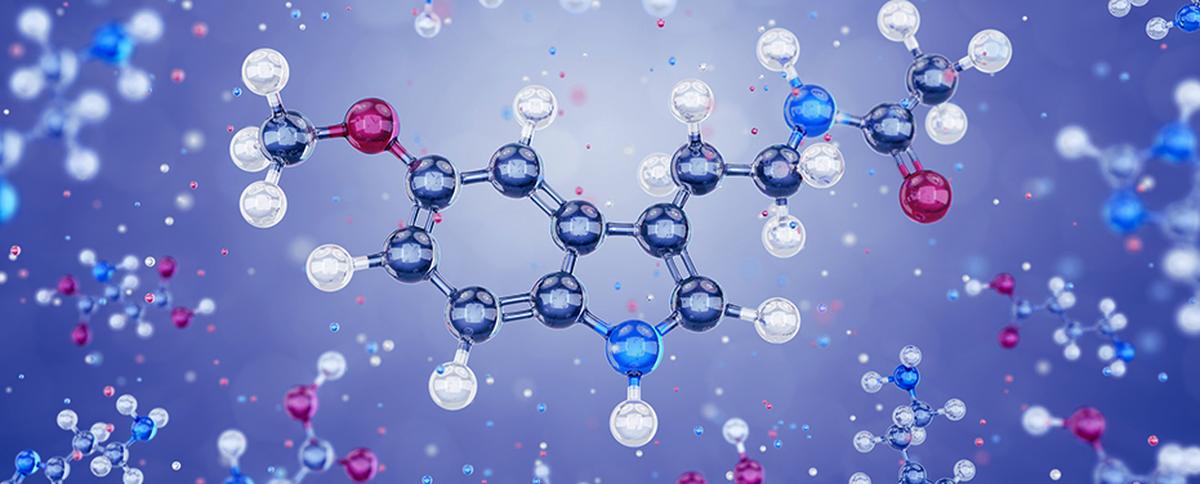Circadian rhythms: how your body’s internal clock regulates your health

Awake all night? Taken a flight across time zones? Each of these events makes us tired, grumpy and out-of-sorts. A short nap may not be enough to catch up on either sleep or a sense of wellness, because the biological rhythm of the body has been disrupted.
There are many biological rhythms in nature, one rhythm familiar to all, is the seasonal flowering of plants. Another such rhythm is the 24-hour-cycle circadian rhythm. The word ‘circadian’ is derived from the Latin words circa which means ‘about’ and dies meaning day. The earth’s day-night cycle directly impacts the biological clock of all living organisms, including plants and microorganisms.
How were circadian rhythms discovered?
The French astronomer Jean Jacques d’Ortous de Mairan was the first to observe circadian rhythms in the Mimosa plant. He observed that the plant unfurled its leaves in the morning and closed them in the evening. This behaviour continued despite the plant being kept in the dark, and was the first demonstration that the behaviour of leaves could continue, independent of light input.
The molecules that control circadian rhythms were discovered in the 1960s through Ronald J. Konopka’s elegant work with Seymour Benzer. He discovered the period or per gene, whose variants either shortened, lengthened or abrogated the 24-hour circadian rhythm of the fruit fly, Drosophila. This showed that the period gene was a component of the 24-hour clock, and not its output. In the 1980s and 1990s, Jeffrey Hall, Michael Rosbash, and Michael Young built on Konopka’s work identifying: (i) the cycling expression of the period gene that was entrained by light, (ii) light-sensitive genes like timeless and cryptochromes, that act along with the period and (iii) feedback regulation that led to the cycling of the period protein. This pioneering research laid the foundations of understanding how the central 24-hour circadian clock operated in the fruit fly brain. Their work was awarded the Nobel Prize in Physiology (Medicine) in 2017.
Joseph Takahashi’s work in mice showed that central clock genes in this organism were similar to those identified in fruit flies, and these genes showed similar light-dependent feedback regulation. Such experiments revealed the existence of an evolutionarily conserved ancient mechanism to tie light input from the natural rotation of the earth to cycling molecules in the brain.

A 3-D model of the hormone melatonin that assists sleep and is sometimes used as a sleep aid to help with jet lag
| Photo Credit:
Getty Images
How do circadian rhythms work?
A ‘master’ clock called the suprachiasmatic nucleus (SCN) is present in the brain and consists of both neurons and supporting glial cells. This master clock drives several peripheral clocks in the heart, liver, spleen, skin, skeletal muscles, lungs, gastrointestinal tract, etc.
The SCN integrates several sensory inputs called zeitgebers which mean ‘time givers’. Zeitgebers for the circadian clock include light, food, noise, stress, social environment and temperature. Among these, light is the strongest zeitgeber. The process of synchronisation of the circadian clock in response to external cues is called ‘entrainment’. Light is sensed by the photosensitive retinal ganglion cells and transmits information to the SCN, which in turn synchronises the peripheral clocks of the body. Exposure to light at dawn advances and entrains the clock and at dusk delays the clock. This entrainment releases hormones, such as cortisol to help us wake up and stay alert (activity rhythm) and suppresses melatonin, the hormone that assists sleep and is sometimes used as a sleep aid to help with jet lag. Aside from these ‘activity rhythms’, these released molecules control feeding, blood pressure and body temperature.
The clock’s impact on wellness
The circadian rhythm sets up physiological rhythms with consequences on wellness. For instance, in the afternoon our reaction times are the fastest. By late evening, cardiovascular strength, blood pressure and body temperature are at their peak. As the sun sets and it becomes dark outside, the pineal gland in the brain releases melatonin. Watching television or working on electronic devices during this time, exposes us to blue light from screens, which has similar effects as the sunlight during the day. This blue light interferes with the action of melatonin and delays not only the onset of sleep, but also disrupts our circadian rhythm.
Many other factors can also disrupt the circadian rhythm. The most common ones include traveling across time zones, shift work, age, medications, food intake and its timing, and neurological disorders. For healthy individuals, exposure in the morning to sunlight outdoors provides the strongest light input to reset and entrain the circadian clock.

Food timings
Food is another zeitgeber that impacts circadian rhythms, eventually controlling metabolism. However, controlling the quality and size of our meals alone is insufficient; the timing of meals is equally important for most living organisms. Researchers have shown that fruit flies fed at the wrong time laid fewer eggs. Mice fed during their “rest period”, were more prone to diabetes and obesity and showed cognitive impairment.
Similarly, in humans, the mistiming of food can affect health. The timing of our meals directly affects the secondary clocks in organs such as the liver, pancreas and gastrointestinal tract. The genes that control the secondary clocks show rhythmic expressions, meaning the levels of proteins they produce also rise and fall in a 24-hour cycle. Genes linked to sugar (glucose), protein and fat metabolism also show stereotypical oscillations in synchrony with circadian rhythms. Even short delays in mealtimes can alter the expression of some genes that provide feedback to circadian rhythms.
Two hormones are key to regulating our appetite: ghrelin and leptin. Ghrelin levels increase during hunger and fall with food intake, while leptin has the opposite effect– it is low when we are hungry, and surges when we feel full, reducing food intake. Thus, ghrelin levels peak and leptin levels are low just before our regular mealtimes. Disruptions in circadian rhythms, typically due to shift-work or sleep deprivation, also perturb the rhythmic release of ghrelin.
Food types and meal timings affect circadian activity and physiological rhythms. Morning fasting affects the metabolism of subsequent meals and affects physical activity and nocturnal feeding. High fat and alcohol consumption disrupt circadian rhythms. Glucose metabolism is directly related to sleep patterns. Shorter sleep durations or disrupted sleep cause a spike in fasting blood glucose and reduce insulin sensitivity. The response of tissues to insulin (sensitivity) is critical to maintaining blood glucose levels. Lack of sufficient sleep and disrupted circadian rhythms can lead to poor regulation of food intake, as well as conditions such as diabetes and weight gain.

The link to exercise
Exercise is not as strong a zeitgeber as light, but, like food, it is a non-photic zeitgeber, and can potentially delay or advance circadian rhythms. Thus, exercise is an additional input to reset disrupted rhythms. Apart from the mode and intensity of exercise, its timing has an equally beneficial effect on the circadian rhythm through the modulation of clock genes.
A study has shown that 45 minutes of aerobic exercise in the evening, as opposed to the morning helps reduce blood pressure in people with hypertension. Another study has shown that evening walks are better at reducing low-density lipoprotein, also known as the ‘bad cholesterol’, and fibrinogen – elevated levels of which can clot blood, creating blockages in blood vessels. Overall, the mode and timing of exercise helps alleviate the risk of cardiovascular diseases. A combination of exercise and its timing can help maintain a good circadian rhythm, which benefits health.

Medication timings
Circadian rhythm also affects the metabolism of drugs in the liver, thus medications are ingested along with our meals or at bedtime. The time of the day also determines how vulnerable we are to infections and how well we respond to vaccines. In other words, our immune responses also oscillate with circadian rhythms.
Cardiovascular diseases (CVDs) are the leading causes of death across the world. A mainstay of delaying CVD is treating elevated cholesterol through statins, a class of cholesterol-reducing drugs. Statins are usually prescribed to be taken in the evening for two main reasons. First, cholesterol biosynthesis in the liver peaks during the night controlled by the peripheral liver circadian clock. Second, most statins have a short half-life. This means half of the drug is eliminated from the bloodstream within a few hours. Taking statins in the evening thus synchronises the effectiveness of the drug during peak periods of cholesterol biosynthesis.

Chronotype, sleep in teenagers and school/work timings
We spend around a third of the day sleeping. Sleep is essential for several processes such as tissue growth, repair and regeneration, elimination of metabolic waste products from the central nervous system etc. It is not just the duration: the time of day that a person sleeps is also important for health. Whether in adults or in children, timely and adequate sleep is essential for a healthy body and mind. While adults need 7-8 hours of sleep, adolescents require more sleep, approximately 8-10 hours. An undisturbed circadian rhythm is important to promote wakefulness and alertness during the day and rest through sleep during the night. However, several global studies report shorter durations or disturbed sleep among adolescents.
Chronotype, a person’s natural inclination with regard to the time of day when they prefer to sleep or when they are most alert or energetic, is important to account for, in how societies function. ‘Larks’ naturally wake up early and are active in the morning while ‘owls’ wake up later, or are active during the later part of the day. Likewise, teenagers normally experience a delayed onset of sleep due to an approximately two-hour shift in their circadian rhythms. This shift is driven by hormonal changes during their growing years. Thus, teenagers sleep late but have to wake up early, around 6 a.m. or 7 a.m., as schools often begin early in the morning. This delayed sleep phase leaves teenagers with fewer hours to sleep and causes major disturbances to their circadian rhythms. This disruption is often exacerbated by access to social stimulation from the internet/messaging, blue light from electronic devices and poor sleep hygiene. Such disturbances lead to difficulties in waking up, daytime sleepiness, an inability to stay attentive, absenteeism, poor school performance etc. It may also lead to anxiety and depression and can worsen the mental health of teenagers.

Researchers and experts hence recommend school timings be rescheduled so that classes start later for adolescents in synchrony with their natural circadian rhythms. This will ensure they do not compromise on their sleep duration and quality, thereby promoting good mental and physical health. There is increasing evidence that shows that a delay in school start timings helps teenagers have better sleep quality and better educational outcomes.
Taking adult chronotypes into consideration in a work environment can also help individuals be both productive and healthy.
To sum up, physiology, a central pillar of human health, is driven by the master circadian clock in the brain that acts on, and via, several peripheral clocks. The clock is entrained primarily by light, but also by meal timings and exercise to maintain normal circadian rhythms. Additionally, the output of the clock in concert with a variety of zeitgebers provides feedback to maintain healthy rhythms. These rhythms likely differ slightly depending on the chronotype of the individual. Disruption of rhythms has been shown to have a variety of detrimental effects leading to sleep disruptions, diabetes, obesity and poor mental health.
(Rohini Karandikar is a science communicator, educator, and facilitator. She currently works as a consultant with the TNQ Foundation. Sandhya P. Koushika is a cellular neurobiologist who works at the Tata Institute of Fundamental Research, Mumbai.)
Published – May 29, 2025 03:00 pm IST















